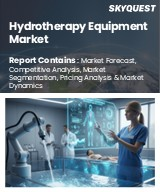
|
시장보고서
상품코드
1703383
세계의 척추 펌프 시장 : 산업 규모, 점유율, 동향, 기회 및 예측 - 용도별, 최종사용자별, 지역별, 경쟁별(2020-2030년)Spinal Pumps Market - Global Industry Size, Share, Trends, Opportunity, and Forecast, Segmented By Application, By End-User, By Region and Competition, 2020-2030F |
||||||
척추 펌프 세계 시장은 2024년에 4억 135만 달러로 평가되었습니다. 예측 기간 동안 6억 8,940만 달러에 달하고, 2030년까지 9.41%의 연평균 복합 성장률(CAGR)을 보일 것으로 예측됩니다.
척추 펌프는 척수강 내 약물 전달 시스템 또는 단순히 펌프라고도 하며, 척수 내 뇌척수액(CSF)에 직접 약물을 표적 전달하기 위해 사용되는 의료기기입니다. 이 약물 전달 방법은 중추 신경계에 약물을 정확하고 제어된 방식으로 투여할 수 있으며, 특히 통증 관리 및 특정 질환의 치료에 있어 여러 가지 이점을 제공합니다. 척추 펌프는 요통, 복합부위통증증후군(CRPS), 신경병증성 통증, 암성 통증 등 다른 치료법에 반응하지 않는 만성 통증 및 중증 통증 관리에 자주 사용됩니다. 척추 펌프는 바클로펜과 같은 근이완제를 척수에 직접 투여하여 다발성 경화증(MS), 뇌성마비, 척수 손상 등의 증상에서 심한 경련을 관리할 수 있습니다. 또한 근긴장이상증, 특정 운동 장애, 방광, 장 기능 장애, 정신 질환 및 난치성 간질 치료에도 사용됩니다.
| 시장 개요 | |
|---|---|
| 예측 기간 | 2026-2030년 |
| 시장 규모 : 2024년 | 4억 135만 달러 |
| 시장 규모 : 2030년 | 6억 8,940만 달러 |
| CAGR : 2025-2030년 | 9.41% |
| 급성장 부문 | 경련 관리 |
| 최대 시장 | 북미 |
주요 시장 성장 촉진요인
기술 발전
주요 시장 과제
비용 절감
주요 시장 동향
임플란트형 펌프 채택 증가
목차
제1장 제품 개요
제2장 조사 방법
제3장 주요 요약
제4장 고객의 소리
제5장 세계의 척추 펌프 시장 전망
- 시장 규모와 예측
- 금액별
- 시장 점유율과 예측
- 용도별(악성 통증, 비악성 통증, 통증 관리, 경성 관리)
- 최종사용자별(대체 케어 센터, ASC, 클리닉, 병원, 장기 케어 센터)
- 기업별(2024년)
- 시장 맵
제6장 아시아태평양의 척추 펌프 시장 전망
- 시장 규모와 예측
- 시장 점유율과 예측
- 아시아태평양 : 국가별 분석
- 중국
- 인도
- 호주
- 일본
- 한국
제7장 유럽의 척추 펌프 시장 전망
- 시장 규모와 예측
- 시장 점유율과 예측
- 유럽 : 국가별 분석
- 프랑스
- 독일
- 스페인
- 이탈리아
- 영국
제8장 북미의 척추 펌프 시장 전망
- 시장 규모와 예측
- 시장 점유율과 예측
- 북미 : 국가별 분석
- 미국
- 멕시코
- 캐나다
제9장 남미의 척추 펌프 시장 전망
- 시장 규모와 예측
- 시장 점유율과 예측
- 남미 : 국가별 분석
- 브라질
- 아르헨티나
- 콜롬비아
제10장 중동 및 아프리카의 척추 펌프 시장 전망
- 시장 규모와 예측
- 시장 점유율과 예측
- 중동 및 아프리카 : 국가별 분석
- 남아프리카공화국
- 사우디아라비아
- 아랍에미리트(UAE)
제11장 시장 역학
- 성장 촉진요인
- 과제
제12장 시장 동향과 발전
- 최근 동향
- 제품 출시
- 인수합병(M&A)
제13장 세계의 척추 펌프 시장 : SWOT 분석
제14장 Porter의 Five Forces 분석
- 업계내 경쟁
- 신규 참여 가능성
- 공급업체의 힘
- 고객의 힘
- 대체품의 위협
제15장 PESTEL 분석
제16장 경쟁 구도
- Medtronic Plc.
- FlowonixMedical, Inc.
- Tricumed Medizintechnik GmbH
- Smith Group Plc
- Johnson & Johnson Private Limited
- Teleflex, Inc.
- Becton Dickinson & Co.
- DePuy Synthes Inc.
제17장 전략적 제안
제18장 회사 소개 및 면책조항
LSH 25.04.29Global Spinal Pumps Market was valued at USD 401.35 Million in 2024 and is expected to reach USD 689.40 Million in the forecast period with a CAGR of 9.41% through 2030. A spinal pump, also known as an intrathecal drug delivery system or simply a pump, is a medical device used for the targeted delivery of medications directly into the cerebrospinal fluid (CSF) within the spinal cord. This method of drug delivery allows for precise and controlled administration of medications to the central nervous system, offering several advantages, particularly in pain management and the treatment of specific medical conditions. Spinal pumps are commonly used to manage chronic and severe pain conditions that are unresponsive to other treatments, such as failed back surgery syndrome, complex regional pain syndrome (CRPS), neuropathic pain, and cancer-related pain. Spinal pumps can help manage severe spasticity in conditions like multiple sclerosis (MS), cerebral palsy, and spinal cord injury by delivering muscle relaxants like baclofen directly to the spinal cord. Spinal pumps are also used to treat conditions such as dystonia, certain movement disorders, bladder, and bowel dysfunction, and, in some cases, psychiatric disorders and refractory epilepsy.
| Market Overview | |
|---|---|
| Forecast Period | 2026-2030 |
| Market Size 2024 | USD 401.35 Million |
| Market Size 2030 | USD 689.40 Million |
| CAGR 2025-2030 | 9.41% |
| Fastest Growing Segment | Spasticity Management |
| Largest Market | North America |
Key Market Drivers
Advancements in Technology
Modern spinal pumps are often programmable, allowing healthcare providers to adjust medication dosages and delivery rates remotely. This flexibility enables personalized pain management plans tailored to each patient's needs. Some spinal pumps offer micro-dosing capabilities, allowing for extremely precise drug delivery. This is particularly beneficial when patients require very low doses of medication or need highly controlled pain management. Advanced spinal pumps are equipped with continuous monitoring and data logging features. These capabilities enable healthcare providers to track the performance of the pump, medication usage, and patient responses over time. Spinal pumps can now be remotely monitored and adjusted using wireless or remote-control devices. Healthcare providers can make real-time adjustments to medication delivery without the need for in-person visits, improving patient convenience. Modern spinal pumps include integrated alarm systems that alert both healthcare providers and patients to any issues or anomalies, such as low medication levels or technical malfunctions. Battery technology has improved, leading to longer-lasting power sources for spinal pumps. This enhances the reliability of these devices and reduces the need for frequent battery replacements. Noise reduction technologies have been integrated into spinal pump designs, making them quieter and less noticeable to patients.
Key Market Challenges
Cost Containment
The upfront cost of acquiring and implanting a spinal pump system can be substantial. This includes the cost of the pump device itself, surgical implantation, hospitalization, and other associated expenses. High initial costs can be a barrier for healthcare facilities and patients. Many spinal pump systems deliver specialized medications that are often more expensive than oral equivalents. The ongoing cost of medications used in spinal pumps can be a financial burden, particularly for long-term therapy. Spinal pump systems require periodic refilling of medication reservoirs, typically every few weeks or months. These refilling procedures come with associated costs for healthcare facilities and patients. Surgical implantation of the spinal pump, as well as follow-up visits for adjustments and monitoring, can add to the overall cost of treatment. The utilization of healthcare resources, including surgical teams, anesthesiologists, pain management specialists, and nurses, contributes to the overall cost of spinal pump therapy. Healthcare facilities must allocate these resources effectively. Ensuring adequate reimbursement for spinal pump therapy is a complex process. It can involve negotiations with insurance providers and adherence to specific criteria for coverage, making it challenging for healthcare facilities and patients to secure financial support. Access to healthcare facilities and providers with expertise in spinal pump therapy may be limited in certain regions, leading to higher costs associated with travel and specialized care.
Key Market Trends
Rising Adoption of Implantable Pumps
Implantable pumps allow for highly precise and controlled drug delivery directly to the cerebrospinal fluid within the spinal cord. This targeted approach minimizes systemic side effects and maximizes the therapeutic effect of medications, making it particularly valuable in pain management and spasticity control. Implantable pumps are highly effective in managing chronic and severe pain conditions that are often refractory to other treatment methods. Patients with conditions like failed back surgery syndrome, complex regional pain syndrome (CRPS), and cancer-related pain benefit from better pain control and improved quality of life. The use of implantable pumps can reduce a patient's reliance on oral or systemic medications, particularly opioids. This is significant in the context of the opioid epidemic and concerns about opioid-related side effects and dependence. Implantable pumps allow for individualized treatment plans. Healthcare providers can adjust medication dosages, delivery rates, and schedules to meet each patient's specific needs, improving the overall quality of care. With implantable pumps, medication waste is minimized because drugs are delivered directly to the target site. This is an important consideration for healthcare cost containment and sustainability. Implantable pumps can provide long-term therapy for chronic conditions, reducing the need for frequent medication adjustments and improving patient adherence. Once implanted, these devices require less day-to-day attention from patients compared to external devices, such as transdermal patches or oral medications. This can lead to improved patient compliance and quality of life.
Key Market Players
- DePuy Synthes Inc.
- FlowonixMedical, Inc.
- Medtronic Plc
- Teleflex, Inc.
- Tricumed Medizintechnik GmbH
- Smith's Group Plc
- Johnson & Johnson Private Limited
- Becton & Dickinson Co.
Report Scope:
In this report, the Global Spinal Pumps Market has been segmented into the following categories, in addition to the industry trends which have also been detailed below:
Spinal Pumps Market, By Application:
- Malignant Pain
- Non-Malignant Pain
- Pain Management
- Spasticity Management
Spinal Pumps Market, By End-User:
- Alternate Care Centers
- ASCs
- Clinics
- Hospitals
- Long Term Care Centers
Spinal Pumps Market, By Region:
- North America
- United States
- Canada
- Mexico
- Asia-Pacific
- China
- India
- South Korea
- Australia
- Japan
- Europe
- Germany
- France
- United Kingdom
- Spain
- Italy
- South America
- Brazil
- Argentina
- Colombia
- Middle East & Africa
- South Africa
- Saudi Arabia
- UAE
Competitive Landscape
Company Profiles: Detailed analysis of the major companies present in the Global Spinal Pumps Market.
Available Customizations:
Global Spinal Pumps Market report with the given market data, TechSci Research offers customizations according to a company's specific needs. The following customization options are available for the report:
Company Information
- Detailed analysis and profiling of additional market players (up to five).
Table of Contents
1. Product Overview
- 1.1. Market Definition
- 1.2. Scope of the Market
- 1.2.1. Markets Covered
- 1.2.2. Years Considered for Study
- 1.2.3. Key Market Segmentations
2. Research Methodology
- 2.1. Objective of the Study
- 2.2. Baseline Methodology
- 2.3. Key Industry Partners
- 2.4. Major Association and Secondary Sources
- 2.5. Forecasting Methodology
- 2.6. Data Triangulation & Validation
- 2.7. Assumptions and Limitations
3. Executive Summary
- 3.1. Overview of the Market
- 3.2. Overview of Key Market Segmentations
- 3.3. Overview of Key Market Players
- 3.4. Overview of Key Regions/Countries
- 3.5. Overview of Market Drivers, Challenges, Trends
4. Voice of Customer
5. Global Spinal Pumps Market Outlook
- 5.1. Market Size & Forecast
- 5.1.1. By Value
- 5.2. Market Share & Forecast
- 5.2.1. By Application (Malignant Pain, Non-Malignant Pain, Pain Management, Spasticity Management)
- 5.2.2. By End-User (Alternate Care Centers, ASCs, Clinics, Hospitals, Long Term Care Centers)
- 5.2.3. By Company (2024)
- 5.3. Market Map
6. Asia Pacific Spinal Pumps Market Outlook
- 6.1. Market Size & Forecast
- 6.1.1. By Value
- 6.2. Market Share & Forecast
- 6.2.1. By Application
- 6.2.2. By End-User
- 6.2.3. By Country
- 6.3. Asia Pacific: Country Analysis
- 6.3.1. China Spinal Pumps Market Outlook
- 6.3.1.1. Market Size & Forecast
- 6.3.1.1.1. By Value
- 6.3.1.2. Market Share & Forecast
- 6.3.1.2.1. By Application
- 6.3.1.2.2. By End-User
- 6.3.1.1. Market Size & Forecast
- 6.3.2. India Spinal Pumps Market Outlook
- 6.3.2.1. Market Size & Forecast
- 6.3.2.1.1. By Value
- 6.3.2.2. Market Share & Forecast
- 6.3.2.2.1. By Application
- 6.3.2.2.2. By End-User
- 6.3.2.1. Market Size & Forecast
- 6.3.3. Australia Spinal Pumps Market Outlook
- 6.3.3.1. Market Size & Forecast
- 6.3.3.1.1. By Value
- 6.3.3.2. Market Share & Forecast
- 6.3.3.2.1. By Application
- 6.3.3.2.2. By End-User
- 6.3.3.1. Market Size & Forecast
- 6.3.4. Japan Spinal Pumps Market Outlook
- 6.3.4.1. Market Size & Forecast
- 6.3.4.1.1. By Value
- 6.3.4.2. Market Share & Forecast
- 6.3.4.2.1. By Application
- 6.3.4.2.2. By End-User
- 6.3.4.1. Market Size & Forecast
- 6.3.5. South Korea Spinal Pumps Market Outlook
- 6.3.5.1. Market Size & Forecast
- 6.3.5.1.1. By Value
- 6.3.5.2. Market Share & Forecast
- 6.3.5.2.1. By Application
- 6.3.5.2.2. By End-User
- 6.3.5.1. Market Size & Forecast
- 6.3.1. China Spinal Pumps Market Outlook
7. Europe Spinal Pumps Market Outlook
- 7.1. Market Size & Forecast
- 7.1.1. By Value
- 7.2. Market Share & Forecast
- 7.2.1. By Application
- 7.2.2. By End-User
- 7.2.3. By Country
- 7.3. Europe: Country Analysis
- 7.3.1. France Spinal Pumps Market Outlook
- 7.3.1.1. Market Size & Forecast
- 7.3.1.1.1. By Value
- 7.3.1.2. Market Share & Forecast
- 7.3.1.2.1. By Application
- 7.3.1.2.2. By End-User
- 7.3.1.1. Market Size & Forecast
- 7.3.2. Germany Spinal Pumps Market Outlook
- 7.3.2.1. Market Size & Forecast
- 7.3.2.1.1. By Value
- 7.3.2.2. Market Share & Forecast
- 7.3.2.2.1. By Application
- 7.3.2.2.2. By End-User
- 7.3.2.1. Market Size & Forecast
- 7.3.3. Spain Spinal Pumps Market Outlook
- 7.3.3.1. Market Size & Forecast
- 7.3.3.1.1. By Value
- 7.3.3.2. Market Share & Forecast
- 7.3.3.2.1. By Application
- 7.3.3.2.2. By End-User
- 7.3.3.1. Market Size & Forecast
- 7.3.4. Italy Spinal Pumps Market Outlook
- 7.3.4.1. Market Size & Forecast
- 7.3.4.1.1. By Value
- 7.3.4.2. Market Share & Forecast
- 7.3.4.2.1. By Application
- 7.3.4.2.2. By End-User
- 7.3.4.1. Market Size & Forecast
- 7.3.5. United Kingdom Spinal Pumps Market Outlook
- 7.3.5.1. Market Size & Forecast
- 7.3.5.1.1. By Value
- 7.3.5.2. Market Share & Forecast
- 7.3.5.2.1. By Indication
- 7.3.5.2.2. By Distribution Channel
- 7.3.5.1. Market Size & Forecast
- 7.3.1. France Spinal Pumps Market Outlook
8. North America Spinal Pumps Market Outlook
- 8.1. Market Size & Forecast
- 8.1.1. By Value
- 8.2. Market Share & Forecast
- 8.2.1. By Application
- 8.2.2. By End-User
- 8.2.3. By Country
- 8.3. North America: Country Analysis
- 8.3.1. United States Spinal Pumps Market Outlook
- 8.3.1.1. Market Size & Forecast
- 8.3.1.1.1. By Value
- 8.3.1.2. Market Share & Forecast
- 8.3.1.2.1. By Application
- 8.3.1.2.2. By End-User
- 8.3.1.1. Market Size & Forecast
- 8.3.2. Mexico Spinal Pumps Market Outlook
- 8.3.2.1. Market Size & Forecast
- 8.3.2.1.1. By Value
- 8.3.2.2. Market Share & Forecast
- 8.3.2.2.1. By Application
- 8.3.2.2.2. By End-User
- 8.3.2.1. Market Size & Forecast
- 8.3.3. Canada Spinal Pumps Market Outlook
- 8.3.3.1. Market Size & Forecast
- 8.3.3.1.1. By Value
- 8.3.3.2. Market Share & Forecast
- 8.3.3.2.1. By Application
- 8.3.3.2.2. By End-User
- 8.3.3.1. Market Size & Forecast
- 8.3.1. United States Spinal Pumps Market Outlook
9. South America Spinal Pumps Market Outlook
- 9.1. Market Size & Forecast
- 9.1.1. By Value
- 9.2. Market Share & Forecast
- 9.2.1. By Application
- 9.2.2. By End-User
- 9.2.3. By Country
- 9.3. South America: Country Analysis
- 9.3.1. Brazil Spinal Pumps Market Outlook
- 9.3.1.1. Market Size & Forecast
- 9.3.1.1.1. By Value
- 9.3.1.2. Market Share & Forecast
- 9.3.1.2.1. By Application
- 9.3.1.2.2. By End-User
- 9.3.1.1. Market Size & Forecast
- 9.3.2. Argentina Spinal Pumps Market Outlook
- 9.3.2.1. Market Size & Forecast
- 9.3.2.1.1. By Value
- 9.3.2.2. Market Share & Forecast
- 9.3.2.2.1. By Application
- 9.3.2.2.2. By End-User
- 9.3.2.1. Market Size & Forecast
- 9.3.3. Colombia Spinal Pumps Market Outlook
- 9.3.3.1. Market Size & Forecast
- 9.3.3.1.1. By Value
- 9.3.3.2. Market Share & Forecast
- 9.3.3.2.1. By Application
- 9.3.3.2.2. By End-User
- 9.3.3.1. Market Size & Forecast
- 9.3.1. Brazil Spinal Pumps Market Outlook
10. Middle East and Africa Spinal Pumps Market Outlook
- 10.1. Market Size & Forecast
- 10.1.1. By Value
- 10.2. Market Share & Forecast
- 10.2.1. By Application
- 10.2.2. By End-User
- 10.2.3. By Country
- 10.3. MEA: Country Analysis
- 10.3.1. South Africa Spinal Pumps Market Outlook
- 10.3.1.1. Market Size & Forecast
- 10.3.1.1.1. By Value
- 10.3.1.2. Market Share & Forecast
- 10.3.1.2.1. By Application
- 10.3.1.2.2. By End-User
- 10.3.1.1. Market Size & Forecast
- 10.3.2. Saudi Arabia Spinal Pumps Market Outlook
- 10.3.2.1. Market Size & Forecast
- 10.3.2.1.1. By Value
- 10.3.2.2. Market Share & Forecast
- 10.3.2.2.1. By Application
- 10.3.2.2.2. By End-User
- 10.3.2.1. Market Size & Forecast
- 10.3.3. UAE Spinal Pumps Market Outlook
- 10.3.3.1. Market Size & Forecast
- 10.3.3.1.1. By Value
- 10.3.3.2. Market Share & Forecast
- 10.3.3.2.1. By Application
- 10.3.3.2.2. By End-User
- 10.3.3.1. Market Size & Forecast
- 10.3.1. South Africa Spinal Pumps Market Outlook
11. Market Dynamics
- 11.1. Drivers
- 11.2. Challenges
12. Market Trends & Developments
- 12.1. Recent Developments
- 12.2. Product Launches
- 12.3. Mergers & Acquisitions
13. Global Spinal Pumps Market: SWOT Analysis
14. Porter's Five Forces Analysis
- 14.1. Competition in the Industry
- 14.2. Potential of New Entrants
- 14.3. Power of Suppliers
- 14.4. Power of Customers
- 14.5. Threat of Substitute Product
15. PESTLE Analysis
16. Competitive Landscape
- 16.1. Medtronic Plc.
- 16.1.1. Business Overview
- 16.1.2. Company Snapshot
- 16.1.3. Products & Services
- 16.1.4. Financials (In case of listed companies)
- 16.1.5. Recent Developments
- 16.1.6. SWOT Analysis
- 16.2. FlowonixMedical, Inc.
- 16.3. Tricumed Medizintechnik GmbH
- 16.4. Smith Group Plc
- 16.5. Johnson & Johnson Private Limited
- 16.6. Teleflex, Inc.
- 16.7. Becton Dickinson & Co.
- 16.8. DePuy Synthes Inc.
17. Strategic Recommendations
18. About Us & Disclaimer
(주말 및 공휴일 제외)


















